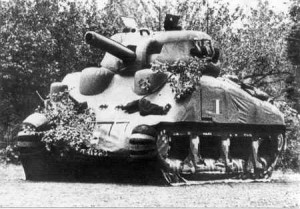This week, to mark the release of the North American edition of The FitzOsbornes at War, I’m going to be blogging about Britain during the Second World War. Today, it’s all about the artists who used their skills to camouflage buildings, guns, lorries, tanks, canals – and even entire cities – to protect them from Nazi attacks. Among these artists was the surrealist painter Julian Trevelyan, who was sent on a military camouflage training course in 1940. He learned how animals camouflage themselves in the wild with protective colouring, then was sent off with his paint tins and brushes to work in Cornwall, where he disguised concrete forts as cottages, public toilets and chicken houses, and used careful countershading to render anti-tank guns invisible against hedges. He also gave lectures to soldiers, showing them slide shows of how to camouflage themselves from air attacks (making sure he included slides “of nude girls under a camouflage net to wake up the men when they had dropped off”1). He was later stationed in North Africa and Palestine, where he disguised military tanks and created a dummy army to deceive the German Afrika Korps.

One of the most famous camouflage experts of the war was magician Jasper Maskelyne, who was recruited into the British army at the same time as Julian Trevelyan. Maskelyne had been particularly bored during the animal-camouflage lectures of their training course (“a lifetime of hiding things on the stage had taught me more about the subject than rabbits and tigers will ever know”2), but he went on to disguise military equipment in the Western Desert and even claimed that he’d made the city of Alexandria temporarily ‘disappear’. He truly was a Master of Illusion.
Tomorrow: Publication day for The FitzOsbornes at War! Also, I talk about some of my favourite non-fiction books about wartime Britain.
_____
